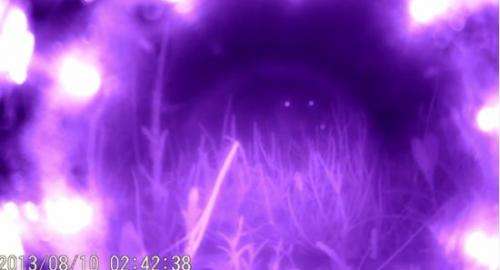Secrets of animal camouflage: Video reveals how predator vision works

(Phys.org) —How do animals see? It's a question that vexes biologists and fascinates anyone who has watched animals go about their business: what does the world look like through their eyes? In a new video, BBSRC-funded scientists are attempting to answer some of these fundamental questions by studying the success of bird and egg camouflage.
The researchers, from the University of Exeter and the University of Cambridge, travelled across Zambia and South Africa and took over 14,000 images and many hours of video footage as part of Project Nightjar. The aim was to work out which predators are able to see the hidden eggs of different ground-nesting birds. Back in the lab, they used specially customised software to recreate the visual world of the predators, analysing what makes objects blend in or stand out from their backgrounds, based on real field data – the first time that camouflage data has been directly linked to survival rates of real animals in the field.
The researchers have taken the analysis one step further by recruiting another predator: humans. By playing the 'citizen science' game Egglab, people can take their place in the evolutionary tree and spot eggs in images derived from the research. The eggs even 'evolve' as the game progresses, yielding yet more data on how types of camouflage evolve in different habitats.
Dr Jolyon Troscianko from the University of Exeter's Sensory Ecology and Evolution group says Project Nightjar came about because theories about how camouflage works hadn't been tested in the wild. "It's very difficult to find a study system where you can link predation with the quality of an animal's camouflage," he said.
Along with co-principal investigators Dr Martin Stevens, also from the University of Exeter, and Dr Claire Spottiswoode from the University of Cambridge, the team developed a study system using two classes of ground-nesting birds inspired by Spottiswoode's previous encounters with nightjars in Africa. "I was bowled over by their camouflage, which led to discussions with Martin about how we could take advantage of these birds for camouflage research, leading to our collaboration on the current project," she said.
Nightjars sit tight on their eggs and rely on the camouflage of the adult bird to outwit their predators. As a result, their eggs are less camouflaged because the adults do the work. In contrast, plovers and coursers run from their nests when danger approaches. Their much more exposed eggs have therefore evolved better camouflage to blend in with their backgrounds, saving the developing chick inside. In each case, it's an arms race between the patterns, colours and contrast of the eggs and the visual acuity of the predators.
Hidden cameras were used to see which predators were eating the eggs. Troscianko recalled that this was a more difficult task than first appeared: "Predation events are unpredictable, which is why this is such a difficult project that has never been done before."
So far, the researchers have found that colour and contrast are often linked, and both are important. As Dr Stevens explained, "What seems to be happening is that disruptive coloration often arises on a range of background types, but is especially common when the background is more variable. Background matching seems especially important on backgrounds that are more uniform (for example open ground), and when individuals are generalist and eggs evolve against two background types, the camouflage takes longer to improve."
Stevens explained that the citizen science games and rigorous fieldwork are complementary. "The fieldwork looks at how camouflage of real animals in the wild affects how likely they are to be eaten by a range of predators, and how camouflage is influenced by behaviour and nesting strategies of the birds. The egg game looks at how camouflage evolves against different habitats under controlled conditions."
Initial data analysis of both the fieldwork results and the citizen science games suggests that egg patterning involves trade-offs between hiding eggs from mammalian eyes or from bird eyes – a classic case of not being able to fool everybody all of the time.
Provided by University of Cambridge





















